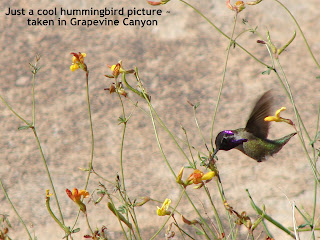According to National Park Service literature, recent research indicates that some of these petroglyphs were made as recent as 150 – 200 years ago, with others dating back to over 800 years. It is believed that the Amacava people (ancestors of the modern day Mohave and perhaps Southern Paiute people) camped in this canyon for days a time and are probably creators of these rock carvings. This site made us realize how much symbols are a fundamental element of human societies not only for people a thousand years ago but still even today.
From here we decided to hike to the end of the canyon, which is about 2 miles one-way. The canyon itself is narrow with a small spring of water that supports an abundance of trees, plants, animals and patches of canyon grape vines from which the canyon got its name. The trail follows the wash of the canyon and often required us to scramble over large boulders and through narrow rock passageways. This made the hike very diverse and interesting the whole way. In the wetter areas, you’ll find yourself hiking through dense brush and plants. Throughout the hike, we had small lizards at our feet for almost every step of the way. We haven’t experience this many in all our desert hikes combined. It was fun seeing all these guys, but we got really excited when we encountered the large lizard shown in the picture below (whom we named Gary, for no reason than he needed a name). This was by far the biggest lizard we have seen in the wild. We’re not sure if he was more curious about us than we were about him.
The canyon ends at the sixth Cottonwood tree grove. Here we had another unexpected surprise and that was a large swarm of bees that had gathered near some fallen hollow logs. We heard them before we got too close, so we hiked up the side of the canyon to give them plenty of space. This canyon with its diverse terrain, interest rock formations, abundance of wildlife and of course the amazing concentration of petroglyphs, made this a MUST hike when you are in the area. If you are unable or are not interested in a hike, then at least go see the petroglyphs…you won’t be disappointed.
How to get there: Take Christmas Tree Pass Road located off Hwy 63 in Nevada at mile marker 13. Travel down a good dirt road (no problem for cars) for about two miles where you’ll see signs pointing the left. This small road leads to the parking area for Grapevine Canyon.







4 comments:
You guys have done it again! Another new place for us to visit! And your wildlife pictures are fabulous. Thanks again for sharing. We are so lucky we found you guys -- or did you find us first?
been to Grapevine Canyon hunting birds Christmas Tree pass used to be decorated in the winter Paul & Sharol
OMG! Do you think Gary, the giant lizard might be poisonous? I hope you gave him a wide berth (like you did the bees)!
I really worry about you two stumbling across a seriously poisonous snake on these fabulous (for young people) hikes. Do you carry a snake bite kit?
Sorry, just my "motherly" instincts kicking in ... LOL!
Take care and stay safe,
Joy and Phil
You are too funny! No snake bite kit - guess like the old days, we'll have to use a tourniquet and suck the venom out, all the while, rinsing the venom from our mouths with whiskey! :)
Post a Comment